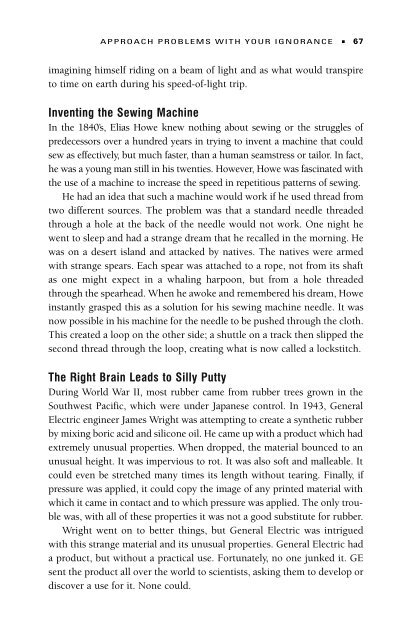A Class with Drucker - Headway | Work on yourself
A Class with Drucker - Headway | Work on yourself
A Class with Drucker - Headway | Work on yourself
Create successful ePaper yourself
Turn your PDF publications into a flip-book with our unique Google optimized e-Paper software.
APPROACH PROBLEMS WITH YOUR IGNORANCE ■ 67<br />
imagining himself riding <strong>on</strong> a beam of light and as what would transpire<br />
to time <strong>on</strong> earth during his speed-of-light trip.<br />
Inventing the Sewing Machine<br />
In the 1840’s, Elias Howe knew nothing about sewing or the struggles of<br />
predecessors over a hundred years in trying to invent a machine that could<br />
sew as effectively, but much faster, than a human seamstress or tailor. In fact,<br />
he was a young man still in his twenties. However, Howe was fascinated <str<strong>on</strong>g>with</str<strong>on</strong>g><br />
the use of a machine to increase the speed in repetitious patterns of sewing.<br />
He had an idea that such a machine would work if he used thread from<br />
two different sources. The problem was that a standard needle threaded<br />
through a hole at the back of the needle would not work. One night he<br />
went to sleep and had a strange dream that he recalled in the morning. He<br />
was <strong>on</strong> a desert island and attacked by natives. The natives were armed<br />
<str<strong>on</strong>g>with</str<strong>on</strong>g> strange spears. Each spear was attached to a rope, not from its shaft<br />
as <strong>on</strong>e might expect in a whaling harpo<strong>on</strong>, but from a hole threaded<br />
through the spearhead. When he awoke and remembered his dream, Howe<br />
instantly grasped this as a soluti<strong>on</strong> for his sewing machine needle. It was<br />
now possible in his machine for the needle to be pushed through the cloth.<br />
This created a loop <strong>on</strong> the other side; a shuttle <strong>on</strong> a track then slipped the<br />
sec<strong>on</strong>d thread through the loop, creating what is now called a lockstitch.<br />
The Right Brain Leads to Silly Putty<br />
During World War II, most rubber came from rubber trees grown in the<br />
Southwest Pacific, which were under Japanese c<strong>on</strong>trol. In 1943, General<br />
Electric engineer James Wright was attempting to create a synthetic rubber<br />
by mixing boric acid and silic<strong>on</strong>e oil. He came up <str<strong>on</strong>g>with</str<strong>on</strong>g> a product which had<br />
extremely unusual properties. When dropped, the material bounced to an<br />
unusual height. It was impervious to rot. It was also soft and malleable. It<br />
could even be stretched many times its length <str<strong>on</strong>g>with</str<strong>on</strong>g>out tearing. Finally, if<br />
pressure was applied, it could copy the image of any printed material <str<strong>on</strong>g>with</str<strong>on</strong>g><br />
which it came in c<strong>on</strong>tact and to which pressure was applied. The <strong>on</strong>ly trouble<br />
was, <str<strong>on</strong>g>with</str<strong>on</strong>g> all of these properties it was not a good substitute for rubber.<br />
Wright went <strong>on</strong> to better things, but General Electric was intrigued<br />
<str<strong>on</strong>g>with</str<strong>on</strong>g> this strange material and its unusual properties. General Electric had<br />
a product, but <str<strong>on</strong>g>with</str<strong>on</strong>g>out a practical use. Fortunately, no <strong>on</strong>e junked it. GE<br />
sent the product all over the world to scientists, asking them to develop or<br />
discover a use for it. N<strong>on</strong>e could.


